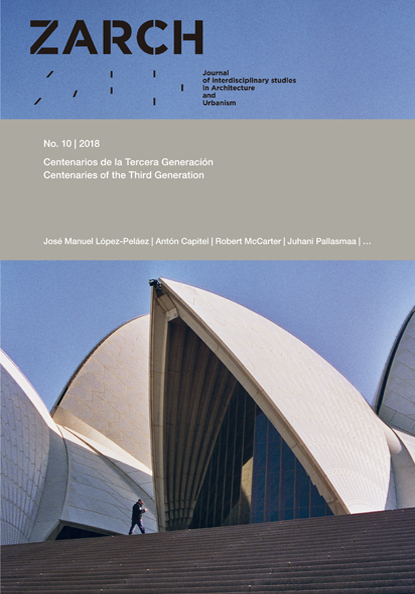Francisco Javier Sáenz de Oíza, a master of bioclimatic adaptation
DOI:
https://doi.org/10.26754/ojs_zarch/zarch.2018102936Keywords:
Architecture, bioclimatic design, Sáenz de OízaAbstract
It can be said that Sáenz de Oíza’s thought and teaching were so rich, that each student could learn in the field that attracted him most, as well as in what we would now call bioclimatic architecture. In his notes of Health and Hygiene the title of "Bioclimate" appears already, and the chapter on "Climate and Physiology" could be part of the classic Bioclimatic Manuals. In an article it is impossible to show the actions related with this aspect in all Sáenz de Oíza's works, but some examples can be analyzed; Torres Blancas, the White City of Alcudia, the Bank of Bilbao in Madrid and the House of Juan Huarte in Formentor are discussed. His handling of the orientation and the influence of the sun, shadows, natural ventilation and wind regime, his design of the envelopes and his use of thermal inertia and properties of the materials or the color are appreciable. The lesson of Francisco Javier Sáenz de Oíza, the one he made as a professor, the one that emerges from his writings, projects and works, and the one that arises when his buildings are analyzed from a bioclimatic adaptation point of view is exemplary, although sometimes it has not been made explicit in all its depth and content. His solutions are aimed at the search for the building of sensitive skin and his intention to achieve energy control and physiological comfort, objectives that matches the needs of the current architecture.
Downloads
References
Capitel, Antón. 2000. Palabras de Arquitectura. Retazos de reflexiones de Sáenz de Oíza. Revista Arquitectura COAM nº extraordinario (septiembre): 83.
European Commission, Directorate General XVII for Energy and Architect´s Council of Europe. 1999. A Green Vitruvius. Principles and Practice of sustainable Architectural Design. Madrid: James & James.
Heidenstam, Verner von. 1915. Nya Dikter. Estocolmo: Bonnier.
Olgyay, Victor. 1963. Desing with Climate. Bioclimatic approach to architectural regionalism. Princenton: University Press.
Sáenz de Oíza, Francisco Javier. 1957. Apuntes Salubridad e Higiene. Madrid: Escuela Técnica Superior de Arquitectura de Madrid.
_____. 1952. El vidrio y la Arquitectura. Revista Nacional de Arquitectura 129-130 (octubre): 11-67.
_____. 1967. La elaboración del proyecto de Torres Blancas de Francisco Javier Sáenz de Oíza. Albumes de Forma Nueva- El Inmueble: 3-8.
_____. 1971. Casa Juan Huarte. Formentor. Revista Arquitectura COAM 154 (octubre): 49-53
_____. 1988. Memoria del concurso del Banco de Bilbao. El Croquis 32/33: 84-107


